Applying the 80/20 rule in your marketing strategy can drive your efficiency to a 100 with a huge boost to your business success.
There are just so many things you must do. It seems like you never have time for anything.
If it sounds familiar, you aren’t alone. In fact, almost every business struggles with not having enough resources to get everything done.
However, you shouldn’t even try…
It’s much better to focus on 20% of things that drive 80% of results.
This is called the Pareto principle or 80/20 rule.
It’ll allow you to work efficiently, stay ahead and improve your business faster.
We’ll look at five 80/20 rule examples and how you can use them in your strategy.
What Is the 80/20 Rule?
Vilfredo Pareto was an Italian economist. Throughout his life, he discovered one fascinating thing.
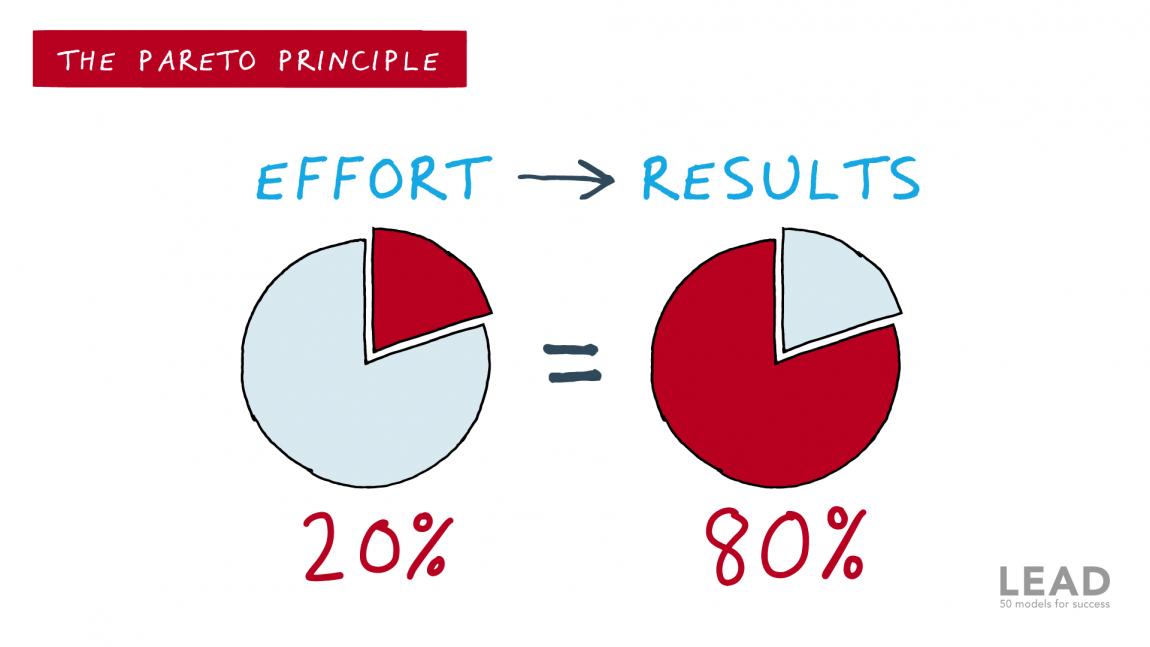
“80% of the land was owned by 20% of people.”
However, as he began to observe it further he realized that the 80/20 rule is everywhere.
“80% of peas from his garden comes from 20% of plants.”
Or
“He wears 20% of clothes, 80% of the time.”
Aren’t you the same?
He formed the Pareto principle or 80/20 rule and it says that 20% of efforts drive 80% of results.
It’s a universal rule that you can use with anything.
How Can That Apply In Marketing?
Pareto principle isn’t about time.
It doesn’t state that you should work only 20% of the time and take vacations other 80%.
It talks about the efforts – what you do in time.
It’s especially important in marketing, where time is money. By applying the 80/20 rule properly, you could.
- Get more sales – focus on the strategies that convert and put all your efforts into them.
- Get valuable customers – find out what kind of customers bring in the highest profits and target them.
- Save tons of resources – eliminate strategies that don’t work and focus on what works instead.
Spend 20% of your time on things that bring 80% of results.
Get more valuable customers, boost sales and increase your ROI. Outperform your competitors and stay on top of the game.
The Five 80/20 Rule Examples In Work
You understand that the Pareto principle is important.
However, how can you apply it in your marketing strategy?
We’ll look at Five 80/20 examples in marketing and find ways to apply them in your strategy.

1. 80% of sales come from 20% of your products.
Uncover that 20% of your products, that are bringing in the most sales. Give them more attention, promote them or even put a discount on them.
Prioritize your efforts on this 20% of products and get more sales.
2. 20% of keywords are responsible for 80% of traffic.
Select the proper keywords to target the right audience.
Find out what keywords bring the most traffic and build your content marketing effort around them.
3. 80% of content marketing leads come from 20% of the content.
Find out what type of content brings the most conversions.
What makes it different from your other content? – Is it the writing style, structure, or headline?
Improve your other posts and make them better.
4. 80% of sales come from 20% of the channels.
“If you shout to everyone, you shout to no one.”
You can’t focus 100% on every advertising channel. You’ll soon run out of resources.
Instead, pick the ones that bring the most sales.
You’ll save tons of resources and get a lot more back in sales.
- 80% of social sharing comes from 20% of social updates.
Find the one social media platform that brings the most traffic.
Focus your whole attention on it.
Learn more about what type of content works. Are your tweets getting more shares or perhaps your Instagram video getting more plays?
Discover what your customers like and stick to it.
How to Apply 80/20 Rule In Your Marketing Efforts
The 80/20 rule examples above sound delightful.
However, how do you come over realizing them?
You may be confused and can’t see the way to apply them to your business. That’s what this chapter is all about.
We’ll dive deep into real-life usage of the Pareto principle.
You’ll see how you can apply it to your business and reap all benefits.
Target The Right Keywords
You found your top-performing product.
Now is time to get more traffic and potential customers to boost your sales and increase revenues.
You can do that by targeting the right keywords.
You could do keyword research from scratch, however, that’s not really the 80/20 style. It’s much better to find keywords that are proven to work.
The easiest way to do that is by stealing top-performing keywords from your competitors.
We’ll be using BiQ Cloud Rank Intelligence for that.
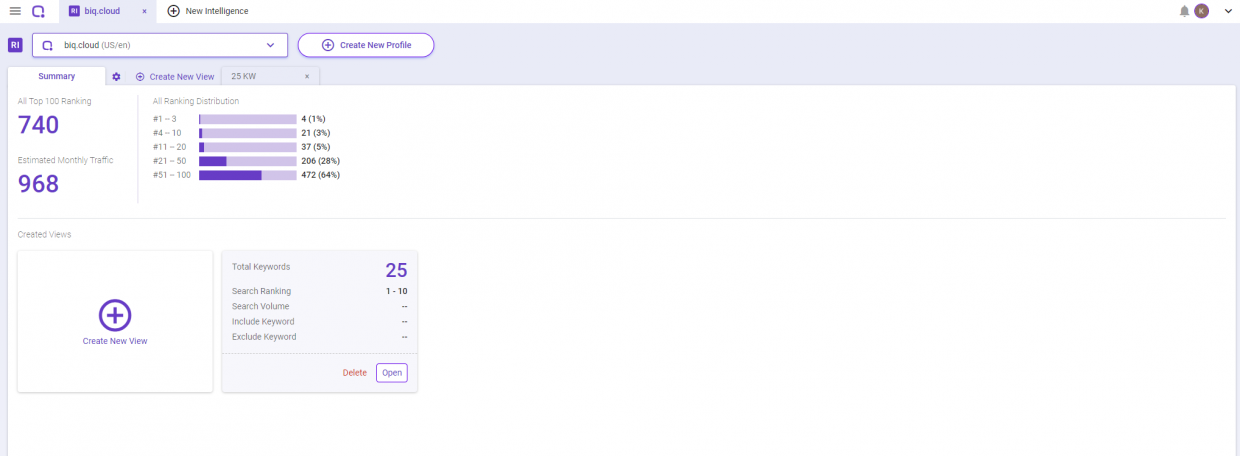
Type in your competitor’s URL and hit Create New Rank Intelligence Profile. Once done, create a new view to generate high-ranking keywords your competitor has.
Leave everything as it is just set the ranking position from 1 to 10. Then, hit Create View to see the in-depth data about competitor’s keywords.
You’ll see the top 20% of your competitors’ keywords, which brings 80% of all their traffic.

Target these keywords in your marketing strategy. Create better content than your competitors and steal their traffic.
You can learn more about competitor analysis in our recent post.
Focus On The Right Marketing Channels
Prioritize quality over quantity.
You can’t be on all social media and use all marketing channels. You’ll run out of resources sooner or later.
It’s much better to stick to one channel that brings the best results. You can find out which one to choose with Google Analytics.
Go to Google Analytics and click on Overview under the Acquisition menu.

You’ll get a report about where your visitors come from.
As you can see, most visitors come from organic searches and direct traffic.
However, when you look closely, it’s the organic search that drives the most conversions. Focus all your efforts on perfecting it.
On the other hand, focus less on email and social. They bring no traffic and little conversions, compared to organic search.
Get your own report and do the same analysis for your business.
Find The Perfect Type Of Content
Content is the king and you should optimize it as much as you can.
However, how to know what your customers like?
Go to Google Analytics and sort your blog posts by the page views. You’ll get a list of top-performing content on your site.
Write down the top 3 blog posts.
You should then make the opposite, sort it by the least page views.
Write down the 3 worst posts.
You’ll now have to compare them and find out what is different. You can then fill the difference gap and make it better.
Go to BiQ Cloud Content Intelligence and fill in the URL to your post.
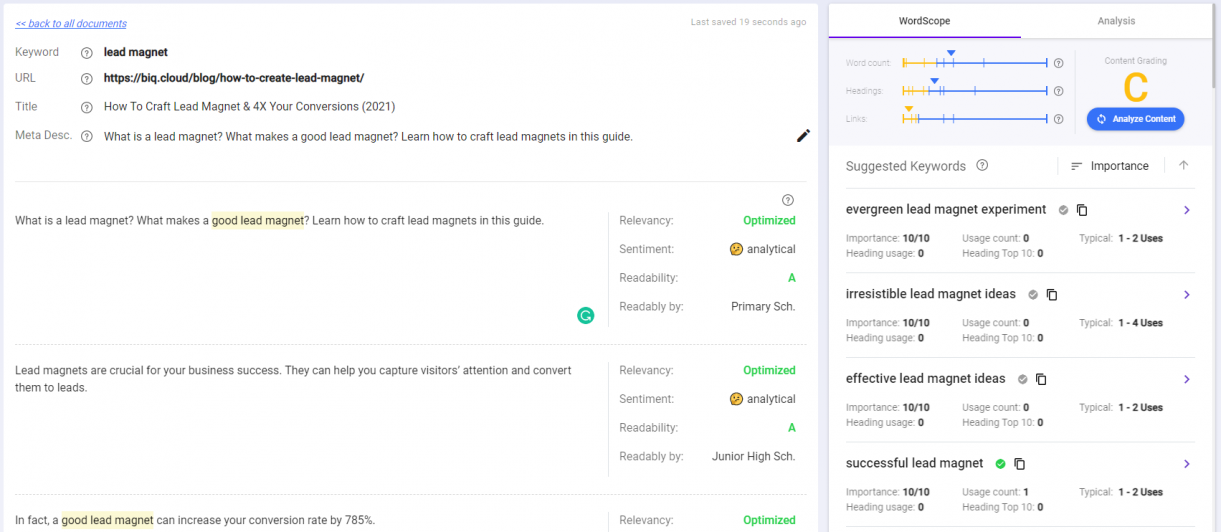
Content intelligence will go through deep analysis and show you in-depth data about your post.
Run this analysis with the 6 blog posts you wrote down and compare them. You should compare:
- Length of content and sentences
- Readability and grade score
- Keyword density and related keywords
- Errors, problems and issues
Find out what separates the best blogs and fill in the difference gap.
How to do a 80/20 rule in business
We’ve talked about how to apply 80/20 for marketing and blogging.
However, they aren’t the only thing in your business.
You must come up with new content ideas, work with a team and finish projects. You should apply 80/20 in there too.
We’ll look at 3 easy ways to improve your business with 80/20.
You’ll discover how to get things done effectively and save resources.
Concentrate On Most Profiting Projects
Focusing on all projects at once is a mistake.
It’s better to focus on the one that bring the most in revenues.
All projects are important, however, only a few of them bring the results you strive for.
The other ones are just tedious things you must get over with.
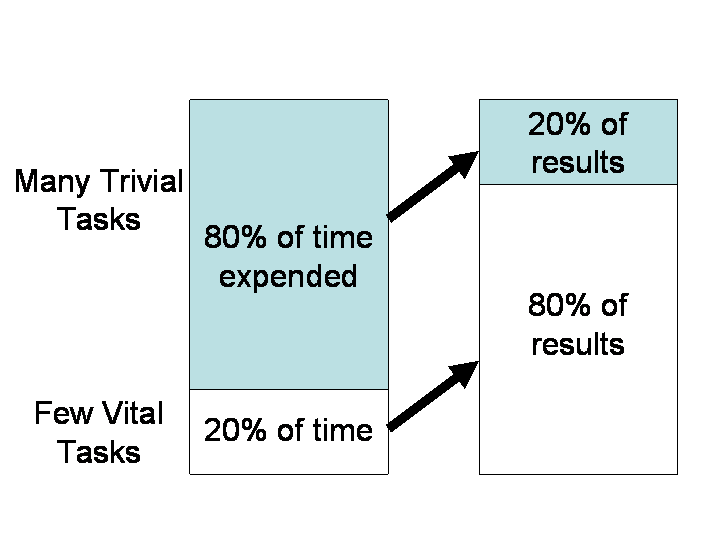
Focus 80% of your efforts on the most profitable projects.
Prioritize what matters the most, work less and get better results.
Focus On The Most Valuable Customers
Most businesses focus on gaining new customers instead of retaining the existing ones.
However, as it turns out, that’s a wrong approach…
“Gaining a customer can cost anywhere between 5X and 25X more than retaining one” – Harvard
It’s a much better strategy to focus on retaining, especially if you’re looking to launch a new product or hoping for a re-purchase.
“Acquiring a new customer can cost 5X more than retaining an existing customer.” – Huify
There are a couple of ways to increase customer retention. The easiest one is to make them feel special.
Give them the attention they deserve. Reach out to them via email, give them loyalty discounts and engage with them. Show them you care and make them stick with you longer.
Learn more about how to retain existing customers in our post.

Outsource Unimportant Work
Trying to get everything done is second to impossible, especially when running a business alone.
You can’t get everything done and it may seem overwhelming.
That’s why you should outsource.
“More than one-third of small businesses currently outsource a business process, and 52% plan to do so in the future” – Clutch
Outsourcing is putting away tasks to other people.
For example, you won’t spend 100 hours on perfecting your design. Instead, you hire a graphic designer to do the job for you.
It’ll allow you to save time and focus on things that matter.
You can easily find out things to outsource in these 3 steps.
1. Identify everything you need to get done
Make a list of all things you need to work on. Include everything from improving the website to creating content and marketing.
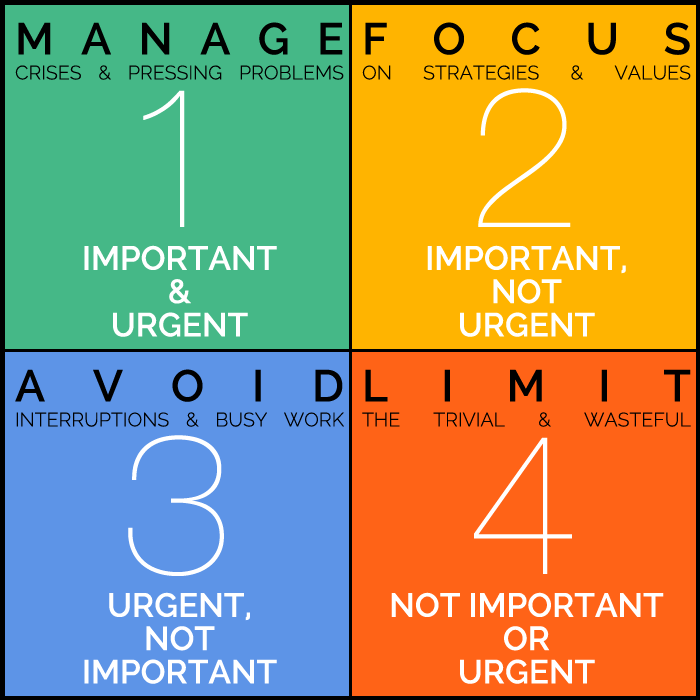
Let’s say you have some of these things on your list
- Create a better graphic design
- Rework your website
- Write more content
- Fix all SEO issues
When you’ve identified all tasks, it’s time to prioritize.
2. Find out what gives you the biggest results
Ask yourself, “What will bring me the biggest results?”
Looking back at the Google Analytics report, you realize that you get most visitors from organic traffic. It’s also the most valuable traffic because it brings you the most conversions.
Therefore you should prioritize ranking higher, improving content and perfecting SEO. When looking back at your list, you quickly realize what should be the top priority.
You should focus on creating more content and improving SEO. These 2 will bring you the biggest results and most sales.
However, you need to get other things done too…
3. Outsource everything insignificant
The rest of the things may be important for you.
You would surely like a nicely-designed website or have a beautiful logo.

However, these things only take up time and drive no results. Hire a freelancer to finish them or postpone them.
Focus on the 20% of things that matter and get the desired results.
It’ll help you improve faster, stay ahead, and get more sales.
The Conclusion
There are just so many things to do.
You have never enough time for everything and it may seem overwhelming.
However, did you know there are only a few things that drive results?
We’ve talked about the five 80/20 rule examples and showed you practical ways on how to use it in your business.
“Focus on 20% of things and drive 80% of results.”
It’ll help you stay ahead, have a more successful business and beat your competitors.




